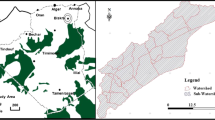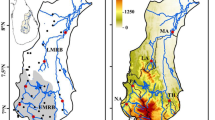Abstract
Due to the scarcity of meteorological observation stations in some areas, there is not enough data available for hydrological simulation as one of the main subjects of hydrology and environmental subjects. This can be partially solved by extracting the required data from global climate centers. The essential data for modeling rainfall-runoff of Dez watershed (16,000 km2), Khuzestan province, Iran, for a 20-year period (1990–2010) were obtained from NCEP CFSR climate center. The simulation (calibration and validation) was done by Soil and Water Assessment Tool (SWAT) and Identification of Unit Hydrographs and Component Flows from Rainfall, Evapotranspiration and Streamflow (IHACRES) models. The SWAT-CUP software has been used for optimization, calibrating and analyzing the uncertainty of the SWAT model by communicating with the model. The ability of the models to simulate the runoff of the basin was determined using the coefficient of determination (R2) and Nash–Sutcliffe efficiency (NSE). R2 and NSE for the SWAT model were 0.75, and 0.78 (calibration), and 0.59 and 0.72 (validation); for the IHACRES model, they were equal to 0.63 and 0.69 (calibration), and 0.54 and 0.66 (validation), respectively. The SWAT model performed better than the IHACRES model by efficiently using the climatic database of NCEP CFSR center. The IHACRES model was also able to simulate the runoff of the watershed with a relatively high correlation with the observational data. It is possible to simulate and predict rainfall-runoff of the Dez watershed using the tested models for taking the measures, which may avoid natural phenomenon including flooding.








Similar content being viewed by others
Data availability
Enquiries about data availability should be directed to the authors.
Code availability
Not applicable.
Notes
Precipitation Estimation from Remotely Sensed Data using Artificial Neural Networks–Climate Data Record.
National Centers for Environmental Prediction (NCEP) Climate Forecast System Reanalysis (CFSR).
European Center for Medium-Range Weather Forecasts.
Global Precipitation Climatology Center.
- Climatic Research Unit.
National Center for Atmospheric Research.
Department of Energy.
References
Abbaspour KC, Rouholahnejad E, Vaghefi S, Srinivasan R, Yang H, Kløve B (2015) A continental-scale hydrology and water quality model for Europe: calibration and uncertainty of a high-resolution large-scale SWAT model. J Hydrol 524:733–752
Ahmadi M, Moeini A, Ahmadi H, Motamedvaziri B, Zehtabiyan GR (2019) Comparison of the performance of SWAT, IHACRES and artificial neural networks models in rainfall-runoff simulation (case study: Kan watershed, Iran). Phys Chem Earth, Parts a/b/c 111:65–77
Alizadeh MJ, Kavianpour MR, Kisi O, Nourani V (2017) A new approach for simulating and forecasting the rainfall-runoff process within the next two months. J Hydrol 548:588–597
Arefinia A, Bozorg-Haddad O, Oliazadeh A, Loáiciga HA (2020) Reservoir water quality simulation with data mining models. Environ Monit Assess 192:1–13
Arnold JG, Moriasi DN, Gassman PW, Abbaspour KC, White MJ, Srinivasan R, Santhi C, Harmel RD, Van Griensven A, Van Liew MW, Kannan N (2012) SWAT: model use, calibration, and validation. Trans ASABE 55:1491–1508
Borzì I, Bonaccorso B, Fiori A (2019) A modified IHACRES rainfall-runoff model for predicting the hydrologic response of a river basin connected with a deep groundwater aquifer. Water 11:2031
Dile YT, Srinivasan R (2014) Evaluation of CFSR climate data for hydrologic prediction in data-scarce watersheds: an application in the Blue Nile River Basin. JAWRA 50:1226–1241
Fuka DR, Walter MT, MacAlister C, Degaetano AT, Steenhuis TS, Easton ZM (2014) Using the Climate Forecast System Reanalysis as weather input data for watershed models. Hydrol Process 28:5613–5623
Guo B, Zhang J, Xu T, Croke B, Jakeman A, Song Y, Yang Q, Lei X, Liao W (2018) Applicability assessment and uncertainty analysis of multi-precipitation datasets for the simulation of hydrologic models. Water 10:1611
Hansen DP, Ye W, Jakeman AJ, Cooke R, Sharma P (1996) Analysis of the effect of rainfall and streamflow data quality and catchment dynamics on streamflow prediction using the rainfall-runoff model IHACRES. Environ Softw 11:193–202
Hope A, Decker J, Jankowski P (2006) Daily River Flow Predictions in Southern California Catchments Using the IHACRES Model and Gridded Rainfall Input Data. In: AGUFM, pp H51J-06.
Jaiswal RK, Ali S, Bharti B (2020) Comparative evaluation of conceptual and physical rainfall–runoff models. Appl Water Sci 10:1–14
Karamage F, Zhang C, Fang X, Liu T, Ndayisaba F, Nahayo L, Kayiranga A, Nsengiyumva JB (2017) Modeling rainfall-runoff response to land use and land cover change in Rwanda (1990–2016). Water 9:147
Karamouz M, Fallahi M, Nazif S, Rahimi Farahani M (2012) Long lead runoff simulation using data driven models. Int J Civ Eng 10(4):328–336
Krause P, Boyle DP, Bäse F (2005) Comparison of different efficiency criteria for hydrological model assessment. Adv Geosci 5:89–97
Li L, Xia J, Xu CY, Singh VP (2010) Evaluation of the subjective factors of the GLUE method and comparison with the formal Bayesian method in uncertainty assessment of hydrological models. J Hydrol 390:210–221
Qing Y, Wang S, Zhang B, Wang Y (2020) Ultra-high resolution regional climate projections for assessing changes in hydrological extremes and underlying uncertainties. Clim Dyn 55:2031–2051
Saha S, Moorthi S, Pan HL, Wu X, Wang J, Nadiga S, Tripp P, Kistler R, Woollen J, Behringer D, Liu H (2010) The NCEP climate forecast system reanalysis. Bull Am Meteorol Soc 91:1015–1058
Santhi C, Arnold JG, Williams JR, Dugas WA, Srinivasan R, Hauck LM (2001) Validation of the swat model on a large rwer basin with point and nonpoint sources 1. JAWRA 37:1169–1188
Tolera MB, Chung IM, Chang SW (2018) Evaluation of the climate forecast system reanalysis weather data for watershed modeling in Upper Awash basin Ethiopia. Water 10:725
Wu D, Cui Y, Xie X, Luo Y (2019) Improvement and testing of SWAT for multi-source irrigation systems with paddy rice. J Hydrol 568:1031–1041
Xie P, Chen M, Yang S, Yatagai A, Hayasaka T, Fukushima Y, Liu C (2007) A gauge-based analysis of daily precipitation over East Asia. J Hydrometeorol 8:607–626
Ye W, Jakeman AJ, Barnes CJ (1995) A parametrically efficient model for prediction of streamflow in an Australian benchmark catchment with complex storage dynamics. Environ Int 21:539–544
Yu Z, Wu J, Chen X (2019) An approach to revising the climate forecast system reanalysis rainfall data in a sparsely-gauged mountain basin. Atmos Res 220:194–205
Zakizadeh H, Ahmadi H, Zehtabian G, Moeini A, Moghaddamnia A (2020) A novel study of SWAT and ANN models for runoff simulation with application on dataset of metrological stations. Phys Chem Earth Parts a/b/c 120:102899
Zhang Z, Liu J, Huang J (2020a) Hydrologic impacts of cascade dams in a small headwater watershed under climate variability. J Hydrol 590:125426
Zhang Y, Xu CY, Hao Z, Zhang L, Ju Q, Lai X (2020b) Variation of melt water and rainfall runoff and their impacts on streamflow changes during recent decades in two Tibetan plateau basins. Water 12:3112
Zhang J, Chen J, Li X, Chen H, Xie P, Li W (2020c) Combining postprocessed ensemble weather forecasts and multiple hydrological models for ensemble streamflow predictions. J Hydrol Eng 25:04019060
Acknowledgements
The authors would like to thank very much the international Publisher AbtinBerkeh Scientific Ltd. Company (https://AbtinBerkeh.com), Isfahan, Iran, for editing the manuscript and revising it according to the journal format.
Funding
The authors have not disclosed any funding.
Author information
Authors and Affiliations
Contributions
MJ: conceptualization, methodology, software.supervision, data curation, validation, visualization, writing—review & editing. HGK: conceptualization, supervision, validation, writing—review & editing. HB: conceptualization, supervision, validation, writing—review & editing.
Corresponding authors
Ethics declarations
Conflict of interest
The authors declare they do not have any conflict of interest.
Additional information
Publisher's Note
Springer Nature remains neutral with regard to jurisdictional claims in published maps and institutional affiliations.
Rights and permissions
About this article
Cite this article
Jaberzadeh, M., Saremi, A., Ghorbanizadeh Kharazi, H. et al. SWAT and IHACRES models for the simulation of rainfall-runoff of Dez watershed. Clim Dyn 62, 2823–2835 (2024). https://doi.org/10.1007/s00382-022-06215-2
Received:
Accepted:
Published:
Issue Date:
DOI: https://doi.org/10.1007/s00382-022-06215-2




